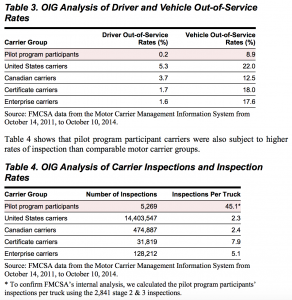After an almost 20-year delay, The Department of Transportation announced last Friday that Mexican trucking companies will soon be able to to apply for authority to conduct long-haul, cross-border trucking services in the United States.
As part of NAFTA, the U.S. was supposed to allow Mexican trucks to travel on border-state roads in 1995, and to drive anywhere in the country by January 2000. Citing safety concerns, the U.S. has kept this NAFTA provision stuck in 1995, restricting Mexican truckers to a 20-mile buffer zone along the southern border. An 18-month-old pilot program that allowed a few Mexican trucks beyond the buffer zone was effectively terminated in March 2009, prompting Mexico to implement tariffs on U.S. industrial and agricultural products totaling $2.4 billion annually from 2009-2011. The tariffs were suspended when a new pilot program was initiated on October 14, 2011, which concluded on October 10, 2014. According to the audit report issued in December 2014, and a follow-up report to Congress by the Federal Motor Carrier Safety Administration:
FMCSA concluded that pilot program participant carriers, as well as Mexico-domiciled and Mexican-owned carriers with existing authority to operate in the United States, performed no worse than United States and Canadian motor carriers. However, the pilot program lacked an adequate and representative sample of participant carriers to project these results across the universe of Mexico-domiciled carriers likely to engage in cross-border operations.
The charts below from the audit report summarize some of the findings:

Not surprising, the Teamsters and The Owner-Operator Independent Drivers Association (OOIDA) strongly oppose allowing Mexican trucking firms to operate more broadly in the U.S., citing safety concerns.
So, are Mexican trucks and drivers safe on U.S. roads? I believe they are not safe…from distracted drivers on U.S. roads. They will be in harm’s way like the rest of us from teenagers and adults alike who text, use a smartphone, eat, drink, read, watch a video, and/or groom themselves while driving.
Here are some sobering statistics from Distraction.gov, the official U.S. government website for distracted driving:
- The number of people killed in distraction-affected crashes decreased slightly from 3,360 in 2011 to 3,328 in 2012. An estimated 421,000 people were injured in motor vehicle crashes involving a distracted driver, this was a nine percent increase from the estimated 387,000 people injured in 2011.
- 10% of all drivers under the age of 20 involved in fatal crashes were reported as distracted at the time of the crash. This age group has the largest proportion of drivers who were distracted.
- Drivers in their 20s make up 27 percent of the distracted drivers in fatal crashes. (NHTSA)
- At any given daylight moment across America, approximately 660,000 drivers are using cell phones or manipulating electronic devices while driving, a number that has held steady since 2010. (NOPUS)
- Engaging in visual-manual subtasks (such as reaching for a phone, dialing and texting) associated with the use of hand-held phones and other portable devices increased the risk of getting into a crash by three times. (VTTI)
Earlier this month on the Nightside radio program here in Boston, Dan Rea interviewed Joel Feldman whose 21 year old daughter was killed by a distracted driver. In her honor, Mr. Feldman created The Casey Feldman Foundation and the group End Distracted Driving. I encourage you to listen to his personal story and efforts to address this growing problem.
Bottom line: Assuming Mexican trucking firms are held to the same safety, security, and inspection standards as U.S. carriers, I don’t believe they will pose a greater risk to U.S. drivers than domestic carriers. The bigger safety risk all of us have to worry about is distracted drivers — which, if we are honest with ourselves, includes most of us.
For related commentary, see Would Robot Drivers Check Facebook While Driving? and Beware, Driverless Cars Are Everywhere!











